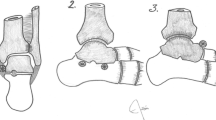Abstract
Introduction
Subtalar dislocation (SD) is an uncommon injury accounting for 1–2% of all dislocations. It involves simultaneous disruption of the talocalcaneal and talonavicular joints, without involvement of the calcaneocuboid or tibiotalar joints or talar neck fracture. We present a retrospective study of pure medial and lateral SDs treated conservatively and discuss the pathogenesis, classification, prognostics and therapeutic aspects of SD.
Materials and methods
Thirty patients, 24 men and 6 women (mean age 33 years; range 18–55) with closed isolated SD were treated conservatively and re-evaluated at 5–12 years. There were 20 medial and 10 lateral dislocations. All patients were managed with immediate closed reduction under general anaesthesia. Open dislocations and SDs associated with fractures were excluded.
Results
The mean AOFAS Ankle–Hindfoot score was 78.8. Seven patients (all with medial SDs) had an AOFAS score of 100; 14 patients (11 with medial and 3 with lateral SD) had a mean AOFAS score of 85; 6 patients (three with medial and three with lateral SD) had a mean AOFAS score of 65; and 3 patients (all with lateral SDs) had a mean AOFAS score of 28. The latter patients subsequently underwent subtalar fusion, with a fair outcome. The mean AOFAS scores of patients with lateral and medial SD were not significantly different (P = 0.05).
Conclusion
Various factors adversely affect outcome, including type of dislocation (lateral/medial, open/closed), severity of the injury, associated fractures, length of immobilization. Management of closed isolated SD is by immediate conservative treatment in order to avoid or reduce the incidence of early soft-tissue and vascular complications and poor long-term outcomes due to post-traumatic arthritis, talus necrosis and subtalar joint stiffness. However, complications may still arise despite correct treatment.


Similar content being viewed by others
References
Allieu Y, Vidal J (1973) La luxation astragalo-scapho-calcanéenne interne du pied. Actualité de Medecin et Chirurgie du Pied 8:205–209
Altman RD (1995) The classification of osteoarthritis. J Rheumatol Suppl 43:42–43
Bibbo C, Anderson RB, Davis WH (2003) Injury characteristics and the clinical outcome of subtalar dislocations: a clinical and radiographic analysis of 25 cases. Foot Ankle Int 24(2):158–163
Brunet P, Dubrana F, Burgaud A, Nen De Le, Lefebre C (2004) Subtalar dislocation: review of ten cases at mean ten-year follow-up. J Bone Joint Surg Br 86B:57
Butel J, Witvoet J (1967) Les fractures et luxations de l’astragale. Rev Chir Orthop 53:494–498
Capelli RM, Galamrini V, Crespi L (2002) Subtalar anterolateral dislocations: case report and literature review. J Orthop Traumatol 3:181–183
Christensen BF, Lorentzen JE, Krogsoe O et al (1977) Subtalar dislocation. Acta Orthop Scand 48:707–711
Decoulx P, Razemon JP (1960) La nécrose aseptique post-traumatique de l’astragale. Ann Chir 14:771–775
DeLee JC, Curtis R (1982) Subtalar dislocation of the foot. J Bone Joint Surg Am 64A(3):433–437
de Palma L, Tamburelli F (1984) La lussazione sottoastragalica nella pratica sportiva. Ital J Sports Trauma 6(2):149–157
Freund KG (1989) Subtalar dislocations: a review of the literature. J Foot Surg 28:429–432
Heck BE, Ebraheim NA, Jackson WT (1996) Anatomical considerations of irreducible medial subtalar dislocation. Foot Ankle Int 17:103–106
Heckman JD (2001) Fractures of the talus. In: Bucholz RW, Heckman JD (Eds) Rockwood and Green’s fractures in adults, 5th edn. Lippincot Williams and Wilkins, Philadelphia, pp 2091–2132
Husson JL, Jourdain R, Rebaud C, Marquer Y, Parcou A, Masse A (1981) Demonstration expérimentale de la physiopathologye des luxations sous-astragaliennes internes. Chir Piede 5:253–256
Inman VT, Mann RA (1978) Principles of examination of the foot and ankle. In: Mann RA (ed) Du Vries’ surgery of the foot, 4th edn. C B Mosby, St. Louis, pp 22–42
Inokuchi S, Hashimoto T, Usami N (1997) Anterior subtalar dislocation: case report. J Orthop Trauma 11(3):235–237
Inokuchi S, Hashimoto T, Usami N (1997) Posterior subtalar dislocation. (a case report ). J Trauma 42(2):310–313
Jorda Lopez E, Espinar Salom E (1981) Las luxaciones astragalo-escafoidea-calcanea. Las ilamadas luxaciones subastragalinas. Chir Piede 5:257–264
Kinik H, Oktay O, Arikan M, Mergen E (1999) Medial subtalar dislocation. Int Orthop 23:366–367
Kitaoka HB, Alexander IJ, Adelaar RS, Nunley JA, Myerson MS, Sanders M (1994) Clinical rating systems for the ankle–hindfoot, midfoot, hallux and lesser toes. Foot Ankle Int 15:349–353
Marotte JH, Samuel P, Moati JC, Lord G, Bombart M (1979) Les luxation sous-astragaliennes internes et externes. A propos de 20 cases. Rev Chir Orthop 65:377–381
Merchan EC (1992) Subtalar dislocations: long-term follow-up of 39 cases. Injury 23:97–100
Merianos P., Papagiannakos K, Hatzis A, Tsafantakis E (1988) Peritalar dslocation: a follow-up report of 21 cases. Injury 19:439–442
Mori F, Garofalo M, Lacalendola GB, Patella V (1982) La lussazione sub talo pedis. Chir Piede 6:117–125
Pehlivan O, Akzam I, Solakogu C, Rodop O (2002) Medial peritalar dislocation. Acta Orthop Trauma Surg 122:541–543
Perugia D, Basile A, Massoni C, Gumina S, Rossi F, Ferretti A (2002) Conservative treatment of subtalar dislocations. Int Orthop 26:56–60
Rockwood CA, Green DP (1984) Fractures, 2nd edn, vol 2. Lippincott, Philadelphia
Tucker DJ, Burian G, Boylan JP (1998) Lateral subtalar dislocation: review of the literature and case presentation. J Foot Ankle Surg 37(3):239–247
Zimmer TJ, Johnson KA (1989) Subtalar dislocations. Clin Orthop 238:190–194
Acknowledgments
The authors are grateful to Dr. Silvia Modena for reviewing the English.
Author information
Authors and Affiliations
Corresponding author
Rights and permissions
About this article
Cite this article
de Palma, L., Santucci, A., Marinelli, M. et al. Clinical outcome of closed isolated subtalar dislocations. Arch Orthop Trauma Surg 128, 593–598 (2008). https://doi.org/10.1007/s00402-007-0459-8
Received:
Published:
Issue Date:
DOI: https://doi.org/10.1007/s00402-007-0459-8




